Reich Ministry of Transport
The Reich Ministry of Transport (German: Reichsverkehrsministerium or RVM) was a cabinet-level agency of the German government from 1919 until 1945, operating during the Weimar Republic and Nazi Germany. Formed from the Prussian Ministry of Public Works after the end of World War I, the RVM was in charge of regulating German railways, roadways, waterways, and the construction industry - a kind of infrastructure agency in today's understanding. In the 1920s, the Ministry's involvement in the rail sector was limited to administrative and technical supervisory functions. The National Railway (Deutsche Reichsbahn) was initially organized as an independent state-owned company to guarantee that Germany paid war reparations according to the provisions of the 1924 Dawes Plan.
| Reichsverkehrsministerium (RVM) (German) | |
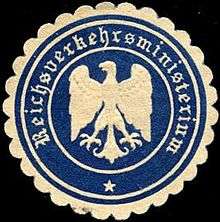 RVM official sealing stamp prior to 1935 | |
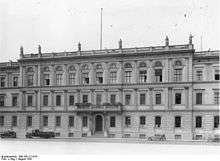 RVM headquarters in Berlin, 1937 | |
| Agency overview | |
|---|---|
| Formed | March 13, 1919 |
| Preceding |
|
| Dissolved | May 23, 1945 |
| Superseding agencies |
|
| Jurisdiction | Germany |
| Headquarters | Voßstraße 34/35, Wilhelmplatz, Berlin-Mitte 52°30′38″N 13°22′58″E |
| Employees | 1.5 Million (1943)[1] |
| Minister responsible | |
| Agency executive | |
| Child agencies |
|
Under Nazi control, the Transport Ministry expanded exponentially. The Reichsbahn, which had become Germany's largest public asset and also the largest such enterprise in the capitalist world at the time,[2] was taken over by the RVM in 1937. Railroads in the German states, transportation associations, and even private transport companies also came under the Nazi government's direct control through the Ministry. During World War II the RVM took over agencies in conquered nations and provided military rail transport. It also became responsible for the deportation of European Jews to extermination camps. The particular unit involved, "No. 21. Bulk Transport", functioned in close cooperation with the SS. The RVM therefore came to play a pivotal role in The Holocaust. The Ministry lived on for a time after the war in the Flensburg Government and was dissolved de facto at the end of May, 1945.
The Ministry's headquarters were located in central Berlin on the Wilhelmplatz. Over time it came to occupy a complex of buildings, including underground air-raid shelters built in 1940. Heavily damaged by Allied bombing, the site wound up in East Berlin in 1949. Portions of it served as the East German Railway headquarters until German Reunification in 1990. Most of the site was left derelict and was demolished in 2012. A large shopping mall was built in its place in 2014, with two small wings historically preserved.
Weimar Republic (1919–1932)
The new Reich cabinet established the RVM on October 1, 1919.[3] By the beginning of 1932, the RVM was operating five departments each headed by directors:
| Department | Director | ||
|---|---|---|---|
| No. | German Name | English Name | |
| E I | Eisenbahn-Verwaltungsabteilung | Railroad Administration | Eduard Vogel |
| E II | Eisenbahntechnische Abteilung | Railway Technical Division | Karl Knaut |
| L | Luftfahrt | Aviation | Ernst Brandenburg |
| K | Kraftverkehr und Schifffahrt | Motor Transport and Shipping | Ulrich Stapenhorst |
| W | Wasserbautechnik | Hydraulic engineering | Johannes Gährs |
Nazi Germany (1933–1945)
Early Period
After the Nazi seizure of power in January 1933, among the first steps in National Socialist policy was the removal of all "non-Aryans" from the civil service. The Transport Ministry became subject to the "Law for the Restoration of the Professional Civil Service" on April 7, 1933. As a result, all Jewish employees and political opponents were dismissed or forced to retire.[4] Civil servants already employed in 1914 or who had fought at the front in World War I were initially spared. The Reichsbahn, which would not come under formal government authority until 1937, was not obliged to apply the law. However, it implemented the measure anyway, with exceptions granted for employees whose technical skills were thought indispensable.[5]

RVM organization also changed during this period. The aviation department was transferred to the Reich Air Ministry, established under Hermann Göring on May 5, 1933. The Motor Transport and Shipping Department was rearranged when Ulrich Stapenhorst left to take up the position of District President of Hannover. Former aviation head Ernst Brandenburg took over Motor Transport and Erich Klausener was appointed Director of Maritime Shipping. The RVM remained sidelined from construction of the largest single Nazi transportation project: the Autobahn. In July 1933, Fritz Todt was directly appointed by Adolf Hitler to build the huge road system quickly, and Transport Minister Paul Freiherr von Eltz-Rübenach thought it prudent not to complain at this obvious bypass of his authority.[6] As was typical of regime, policies were fractured between strong personalities in differing agencies, creating both vertical and horizontal conflicts.[7]
On 24 June 1934, Maritime Director Klausener delivered a passionate speech at the Catholic Congress in Berlin that was critical of Nazi repression of the church. Viewed as an open challenge to the regime, Klausener was shot inside the Ministry building six days later during the Night of the Long Knives. SS officer Kurt Gildisch, who carried out the assassination on the direct orders of Reinhard Heydrich, was promoted in rank to SS-Sturmbannführer.[8] The act also served to intimidate remaining critics of the regime at the Ministry into silence. Max Waldeck was appointed in Klausener's place. During this period the RVM was organized as follows:
| Department | Director | ||
|---|---|---|---|
| No. | German Name | English Name | |
| E I | Eisenbahn-Verwaltungsabteilung | Railroad Administration | Eduard Vogel |
| E II | Eisenbahntechnische Abteilung | Railway Technical Division | Karl Knaut |
| K | Kraftverkehr | Motor Transport | Ernst Brandenburg |
| S | Schifffahrt | Shipping | Erich Klausener (1933–34) Max Waldeck (after 1934) |
| W | Wasserbautechnik | Hydraulic engineering | Johannes Gährs |
Gleichschaltung and the Reichsbahn merger

Between mid-1933 and 1937 the Reich government instituted the policy of Gleichschaltung, loosely translated as "synchronization" or "bringing into line." This was a process by which the state began establishing totalitarian control over all aspects of the public sector. A primary example of this occurred in 1934, when the RVM took over the Association of German Transport Authorities (German: Verband Deutscher Verkehrsverwaltungen), effectively stripping all independent transport-related trade associations and non-governmental organizations of their influence.[9]
The apex of this process occurred at a cabinet meeting on January 30, 1937. Adolf Hitler declared the "Law for the Reorganization of Relations between the Reichsbank and the Reichsbahn",[10] effectively placing the bank and railroads under the regime's direct authority. Ostensibly the law's purpose was to eliminate "foreign influence" from key national infrastructure; in reality it was about the dismissal of remaining Jews and political opponents, as well as the filling of positions with reliable Nazis.[11] During the meeting Hitler also used the occasion of the 4th anniversary of the seizure of power to offer a Golden Party Badge to those ministers who were still not NSDAP members. Transport Minister Paul Freiherr von Eltz-Rübenach, a devout Catholic, explicitly declined the award to protest the rising conflict between the government and the Church. Hitler was outraged and Eltz-Rübenach was immediately forced to resign, becoming a "suspect person" closely monitored by the Gestapo.[12]
Reichsbahn General Director Julius Dorpmüller was then appointed Transport Minister and its Board of Directors was transferred to the RVM on February 2, 1937. The Ministry grew enormously in size and existing department heads were given the rank of Ministerial Director. A further adjustment to Ministry occurred under the Reichsbahn Act of July 11, 1939, wherein the Transport Minister retained the role of Director General of the National Railway by the simple virtue of his office. Dorpmüller now controlled the entire national infrastructure, but saw himself as an apolitical technocrat and did not join the Nazi Party even though it would have been advantageous to do so. The chancellery later ordered his induction into the party and he was informed of the fact by the party treasurer.[13]
| Department | Ministerial Director | State Secretary | ||
|---|---|---|---|---|
| No. | German Name | English Name | ||
| E I | Verkehrs- und Tarifabteilung | Rail Transport and Tariff | Paul Treibe | Wilhelm Kleinmann (1937–1942) Albert Ganzenmüller (1942–1945) |
| E II | Betriebs- und Bauabteilung | Operational Management and Construction | Max Leibbrand | |
| E III | Maschinentechnische und Einkaufsabteilung | Mechanical Engineering and Purchasing | Werner Bergmann | |
| E IV | Finanz- und Rechtsabteilung | Finance and Law | Alfred Prang | |
| E V | Eisenbahntechnische Abteilung | Railway Engineering | Hermann Osthoff | |
| E VI* | Eisenbahn-Bauabteilung (1939–1945) | Railroad Construction | Willy Meilicke | |
| E VII* | Eisenbahn-Bauabteilung (1940–1942) | Railroad Construction | ||
| Group A | Allgemeine Gruppe für Personalfragen der höheren Beamten, internationale Angelegenheiten, Kabinettsangelegenheiten, Propaganda | General Group for personnel questions of senior officials, international affairs, cabinet affairs, propaganda | Theodor Kittel | |
| Group L | Landesverteidigung und Eisenbahnwehrmachtliche Angelegenheiten | National Defense and Military Railway Affairs | Friedrich Ebeling | |
| K | Kraftverkehr | Motor Transport | Ernst Brandenburg | Gustav Koenigs (1935–1940)
|
| S I | See- und Binnenschifffahrt | Maritime and Inland Waterways Shipping | Max Waldeck | |
| S II* | Verbindung Seeschifffahrt-Marine (1940–1945) |
Navy-Maritime Shipping Laison | ||
| W | Wasserbautechnik | Hydraulic Engineering | Johannes Gährs | |
*Additional departments set up in wartime
World War II

The Transport Ministry's structure and leadership changed only slightly during the war. A new railway construction department E VI was established in 1939 under Willy Meilicke, split off from department E II. In 1940 it was further reinforced by a second building department, E VII, as the expansion of the Reich and wartime demands reached their peak. After the forced retirement of maritime State Secretary Gustav Koenigs in 1940, his responsibilities were transferred to Paul Wülfing von Ditten. The Department of Maritime and Inland Shipping was split into Economic (full name in German: Wirtschaftliche Führung der Seefahrt) and Naval divisions.
On 4 November 1939, one month after the defeat of Poland, the western part of Second Polish Republic was incorporated into Germany and its infrastructure taken over by the RVM. Southeastern Poland was organized into the General Government under Hans Frank, a logistically distinct entity centered in Krakow. The Polish State Railways in this area were organized into the General Directorate of the Eastern Railway (German: Generaldirecktion der Ostbahn or Gedob or Ostbahn), financially and operationally separate from the Reichsbahn.[14]
German policy in the occupied countries of the west were much different. The invasion of Norway and Denmark in April, 1940, placed little burden on the RVM as those countries were allowed to run their railroads as before.[15] On 1 August 1940, after the victory in the West, the Belgian, Dutch and French national railways were returned to local control under German "observation", except in coastal areas where all transport remained with the Wehrmacht.[16] Luxembourg was the exception. On November 1, 1941, the Grand Duchy of Luxembourg was annexed by Germany and its entire infrastructure, including all privately owned railways, were turned over to the Transport Ministry.[17]
From 1942–1944, the primary task of the RVM was supporting the German war economy and supplying the enormous needs of the Wehrmacht on the Eastern Front. The faltering situation in the East began presenting critical transport problems as early as January, 1942. Army Group Center, which alone required 75 supply trains per day, in actuality received only 25 to 40. At the request of Julius Dorpmüller, Hitler ordered the Ostbahn be subordinated to the RVM on 4 January 1942 with a special branch office: Zweigstelle Osten des Reichsverkehrsministeriums. The RVM thus expanded further and became responsible for all rail operations in occupation zones behind army field rail commands.[18]
The Holocaust
In early 1940, a new unit was commissioned in the RVM Rail Operations Department E II: No. 21 Massenbeförderung or "Mass Transport". It was responsible for the organization and timetables of special trains deporting Jews from Germany and the occupied territories, working closely with the SS Reich Main Security Office. Following the Wansee Conference in 1942, transports also began running directly to the extermination camps.[19] As a result, the RVM became responsible for a substantial part of The Holocaust and was an essential component that made its full scale possible.[20][21]
There is no record that Minister Dorpmüller ever considered the moral implications of this. So long as the Reichsbahn maintained its internal autonomy, he served whatever transport requirements the regime demanded. He was considered one-dimensional, only interested in running railroads.[22] US Army interrogations shortly after the war assigned little or no personal responsibility to RVM employees. The US further determined that, with limited exceptions, the personnel held only "lukewarm" connections to the Nazi Party.[23] Americans were far more concerned with retaining key staff to rebuild Germany, stating employees were "very cooperative and anxious to help in the reconstruction of the German Railway System."[23]
List of Reich Transport Ministers (1919–1945)
Political Party: Centre SPD DDP DVP DNVP BVP KVP NSDAP None
| Portrait | Name (Birth–Death) |
Term of Office | Political Party | Cabinet | |||
|---|---|---|---|---|---|---|---|
| Took Office | Left Office | Duration | |||||
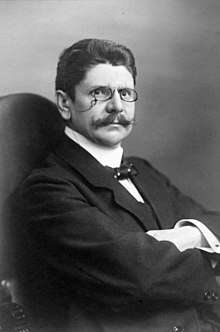 |
Johannes Bell (1868–1949) |
Feb 13, 1919 | May 1, 1920 | 77 days | Centre Party | Scheidemann Bauer Müller I | |
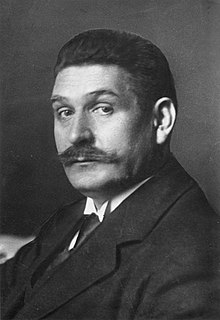 |
Gustav Bauer 1870–1944 |
May 2, 1920 | Jun 21, 1920 | 50 days | Social Democratic Party (SPD) | Müller I | |
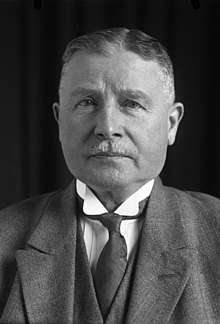 |
Wilhelm Groener (1867–1939) |
Jun 25, 1920 | Aug 12, 1923 | 3 years, 48 days | Non-partisan | Fehrenbach Wirth I Wirth II Cuno | |
— |
Rudolf Oeser (1858–1926) |
Aug 13, 1923 | Oct 11, 1924 | 1 year, 59 days | German Democratic Party (DDP) | Stresemann I Stresemann II[1] Marx I Marx II | |
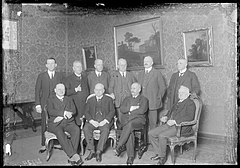 |
Rudolf Krohne (1876–1953) |
Oct 12, 1924 | Dec 17, 1926 | 2 years, 66 days | German People's Party (DVP) | Luther I Luther II[2] Marx III | |
 |
Wilhelm Koch (1877–1950) |
Jan 28, 1927 | Jun 12, 1928 | 1 year, 136 days | German National People's Party (DNVP) | Marx IV | |
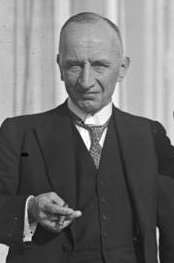 |
Theodor von Guérard (1) (1863 – 1943) |
Jun 27, 1928 | Feb 6, 1929 | 224 days | Centre Party | Müller II | |
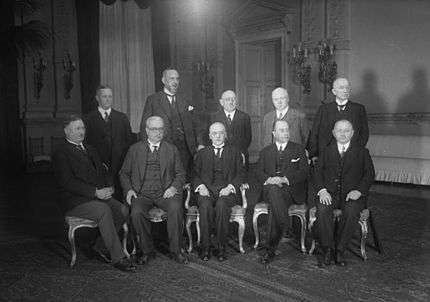 |
Georg Schätzel (1874–1934) |
Feb 7, 1929 | Apr 12, 1929 | 64 days | Bavarian People's Party (BVP) | ||
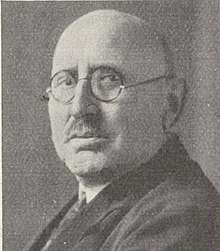 |
Adam Stegerwald (1874–1945) |
Apr 13, 1929 | Mar 27, 1930 | 348 days | Centre Party | ||
 |
Theodor von Guérard (2) (1863 – 1943) |
Mar 30, 1930 | Oct 7, 1931 | 1 year, 191 days | Centre Party | Brüning I | |
 |
Gottfried Treviranus (1891–1971) |
Oct 9, 1931 | May 30, 1932 | 234 days | Conservative People's Party (KVP) | Brüning II | |
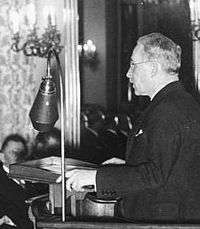 |
Paul Freiherr von Eltz-Rübenach (1875–1943) |
Jun 1, 1932 | Feb 2, 1937 | 4 years, 246 days | Non-partisan | Papen Schleicher Hitler | |
 |
Julius Dorpmüller (1869–1945) |
Feb 2, 1937 | May 23, 1945 | 8 years, 110 days | Non-partisan until Jan 1941, then Nazi Party (NSDAP) |
Hitler Goebbels Dönitz | |
1 The SPD withdrew from the Stresemann II Cabinet on 3 November 1923.
2 The DNVP withdrew from the Luther I Cabinet on 26 October 1925.
List of State Secretaries (1919–1945)
Staatssekretäre
_1942_klein.jpg)
- Max Peters (1919–1920), Leiter der Wasserstraßen-Abteilung
- Karl von Stieler (1919–1923)
- Paul Kirschstein (1920–1924), Leiter der Wasserstraßen-Abteilung
- Georg Bodenstein (1920–1924), Leiter der Zweigstelle Preußen-Hessen
- Max Kumbier (1921–1924), Leiter der eisenbahntechnischen Abteilung
- Johannes Vogt (1923–1924)
- Rudolf Krohne (1923–1924)
- Friedrich Wilhelm Gutbrod (1926–1932)
- Gustav Koenigs (1932–1940)
- Wilhelm Kleinmann (1937–1942)
- Albert Ganzenmüller (1942–1945)
Buildings
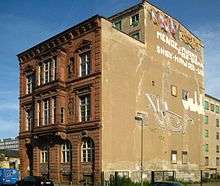
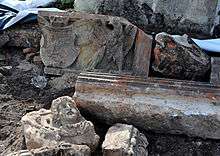
The headquarters of the Ministry were located in the Berlin-Mitte district at Voßstraße 34/35. The historicist central building initially housed the Prussian Ministry of Commerce, then the Prussian Ministry of Public Works, and was greatly enlarged by prominent German architect Richard Lucae between 1875 and 1878. As the RVM grew in the 1930s, it came to occupy an extensive range of buildings with façades on three streets: Voßstraße, Leipziger Straße and the Wilhelmstraße. It first expanded into the adjacent Imperial era mansion at Leipziger Straße 125 in 1937, then into the Deutsches Reichsbahn headquarters at Voßstraße 33 in 1939.
Just before the outbreak of World War II, construction of a large air-raid shelter with a 2.6-meter-thick concrete ceiling began under the Ministry courtyard and was completed in 1940. This was an extension of the Vorbunker under the New Reich Chancellery across the street. The RVM bunker included a passageway to the U2 subway tunnel south of the Kaiserhof station to provide a rail escape route for Nazi leadership.[24] As the intensity of Allied bombing increased in 1944, essential RVM staff were moved southeast of Berlin to a secret area in Groß Köris on the western shore of the Güldensee, at a special rail siding code-named "Fishing Lodge".[25] By the end of the war, the two ancillary wings of the Ministry were the only parts of the complex left standing - the rest was a ruin.
From 7 October 1949 the site was located in East Berlin. The GDR demolished the damaged buildings above ground and filled the basements with rubbish in the 1950s. The usable structure at Voßstraße 33 became the administration building for East German railways until after German reunification in 1990. By 1996 the address was empty, fell into disrepair, and became a site for illegal parties. In 2004 the association "Art and Culture House Voßstraße e.V." began using the building as a gallery and events venue. At Leipziger Straße 125, a library and medical facilities were located next to a travel agency. The West German construction company "Hermann Koehne", mainly active in railroad track construction, had its headquarters there from 1990 to 1996. The building stood empty after that.[26]
After a long-running legal dispute between Deutsche Bahn and the Federal Government, the approximately 10,000 m² site was sold in April 2012 to Berlin Investor Harald Huth. Demolition of the still existing parts of the Ministry, including cellars on the Wilhelmstraße and buried elements of the air-raid bunkers, began in September 2012. The historic Leipziger Straße 125 and Voßstraße 33 were preserved and are today under monument protection.[26] By September 2014 the rest of the site was occupied by a new retail, hotel, office and apartment complex incorporated into the Mall of Berlin, one of the largest shopping centers in Germany.[27]
Notes
- Mierzejewski 2000, p. 44.
- Millward 2005, p. 153.
- Mierzejewski 1999, p. 12.
- Stackelberg & Winkle 2002, p. 150-5.
- Gottwaldt 2009, p. 88.
- Kitchen 2008.
- Zeller 2007, p. 51.
- Hoffmann 2000, p. 49.
- Hundert Jahre in Essen auf Draht--die Strassenbahn : ein Lese-Bilder-Buch zu einem Jahrhundert Verkehrs- und Technikgeschichte der Strassenbahn in Essen (in German), Essen: Klartext, 1993, ISBN 3-88474-070-9
- Reichsgesetzblatt 8/1937: Gesetz zur Neuregelung der Verhältnisse der Reichsbank und der Deutschen Reichsbahn. In: Reichsgesetzblatt – Teil II, Year 1937, p. 47–54 (Online bei ANNO)
- Gottwaldt & Schulle 2007, p. 100.
- Mierzejewski 2000, p. 24.
- Mierzejewski 2000, p. 14.
- Mierzejewski 2000, p. 79.
- Mierzejewski 2000, p. 82.
- Mierzejewski 2000, p. 83.
- Federmeyer 2007, p. 72.
- Mierzejewski 2000, p. 101.
- Engwert & Kill 2009, p. 50.
- Mierzejewski 2000, p. xi.
- Nachama 2012, p. 67.
- Mierzejewski 2000, p. 30.
- Kubala, Paul (30 May 1945). "Reich Ministry of Transport, Reichsbahn Division / SECRET / Seventh Army Interrogation Center / APO 758 / U.S. Army". Law Collections. Ithaca: Cornell University Law Library. Retrieved 6 Feb 2017.
- Müller, Denny (2015). "Reichsverkehrsministerium" [Reich Transport Ministry]. modernruins.de (in German). Berlin: Berliner Unterwelten e.V. Retrieved 5 Feb 2017.
- Rüchel, Burkhart (2015). "Reichsverkehrsministerium: Gross Koeris". arche-foto.com (in German). Berlin: Burkhart Rüchel Fotografie. Retrieved 5 Feb 2017.
- Kerbel, Barbara; Voss, Klaus (26 May 2012). "Immobilien: Große Filets Ausverkauft - Harald G. Huth erwirbt 10 000-qm-Areal in Mitte" [Property: Large Fillets Sold Out - Harald G. Huth Acquires 10,000-square-meter Area in Mitte]. tagesspiegel.de (in German). Berlin: Der Tagesspiegel. Retrieved 5 Feb 2017.
- Klesman, Martin (10 August 2014). "Einkaufszentrum in Berlin: Mall of Berlin eröffnet erst Ende September" [Shopping Center in Berlin: Mall of Berlin Opens in Late September]. berliner-zeitung.de (in German). Berlin: Berliner Zeitung. Retrieved 5 Feb 2017.
References
- Engwert, Andreas; Kill, Susanne, eds. (2009). Sonderzüge in den Tod: die Deportationen mit der Deutschen Reichsbahn; eine Dokumentation der Deutschen Bahn AG; Begleitdokumentation der Deutschen Bahn AG zur gleichnamigen Wanderausstellung (in German). Köln: Böhlau. ISBN 978-3412203375.CS1 maint: ref=harv (link)
- Federmeyer, Ed (2007). Eisenbahnen in Luxemburg (in German). Gernrode/Harz: W. Herdam Fotoverlag. ISBN 978-3-933178-21-3.CS1 maint: ref=harv (link)
- Gottwaldt, Alfred; Schulle, Diana (2007). Juden ist die Benutzung von Speisewagen untersagt: Die Antijüdische Politik des Reichsverkehrsministeriums Zwischen 1933 und 1945 [Jews are Forbidden in the Dining Car: the anti-Jewish policy of the Reichsverkehrsministerium between 1933 and 1945] (in German). Teetz: Hentrich & Hentrich. ISBN 978-3-938485-64-4.CS1 maint: ref=harv (link)
- Gottwaldt, Alfred (2009). Dorpmüllers Reichsbahn die Ära des Reichsverkehrsministers Julius Dorpmüller ; 1920 - 1945 (in German). Freiburg im Breisgau: EK-Verlag GmbH. ISBN 978-3-88255-726-8.CS1 maint: ref=harv (link)
- Hoffmann, Peter (2000). Hitler's personal security. Cambridge, Massachusetts: Da Capo Press. ISBN 978-0-30680-947-7.CS1 maint: ref=harv (link)
- Kitchen, Martin (2008). The Third Reich: Charisma and Community. Harlow, England: Pearson Longman. ISBN 9781317866350.CS1 maint: ref=harv (link)
- Linden, Walter (1959), "Eltz-Rübenach, Paul Freiherr von", Neue Deutsche Biographie (NDB) (in German), 4, Berlin: Duncker & Humblot, pp. 470–471; (full text online)
- Mierzejewski, Alfred (1999). The Most Valuable Asset of the Reich: A History of the German National Railway, Volume 1 1920 - 1932. 1. Chapel Hill: University of North Carolina Press. ISBN 9780807824962.CS1 maint: ref=harv (link)
- Mierzejewski, Alfred (2000). The Most Valuable Asset of the Reich: A History of the German National Railway, Volume 2 1933 - 1945. 2. Chapel Hill: University of North Carolina Press. ISBN 9780807860885.CS1 maint: ref=harv (link)
- Mierzejewski, Alfred (2005). Hitler's trains. Stroud, England: Tempus. ISBN 9780752429816.CS1 maint: ref=harv (link)
- Millward, Robert (2005). Private and Public Enterprise in Europe: Energy, Telecommunications and Transport, 1830-1990. Cambridge, UK: Cambridge University Press. ISBN 9780521835244.CS1 maint: ref=harv (link)
- Nachama, Andreas (senior editor) (2012). Die Wilhelmstraße 1933-1945 - Aufstieg und Untergang des NS-Regierungsviertels: Ein Begleitkatalog zur gleichnamigen Ausstellung [Wilhelmstraße 1933-1945: The Rise and Fall of the Nazi Government Quarter. Published in conjunction with the exhibition] (in German and English). Berlin: Topographie des Terrors. ISBN 978-3-941772-10-6.CS1 maint: ref=harv (link)
- Stackelberg, Roderick; Winkle, Sally (2002). The Nazi Germany Sourcebook : an Anthology of Texts. New York: Routledge. ISBN 978-0415222143.CS1 maint: ref=harv (link)
- Zeller, Thomas (2007). Driving Germany: The Landscape of the German Autobahn, 1930-1970. New York: Berghahn Books. ISBN 9781845453091.CS1 maint: ref=harv (link)
External links
- "Reichsverkehrsministerium Berlin - Der Bunker", YouTube video of the RVM bunkers in September, 2012.
- Mall of Berlin (in English) Official website.
- picture documentation (2012), as well as alternative location near Groß Köris (2015) at arche-foto.com
| Wikimedia Commons has media related to Reichsverkehrsministerium. |